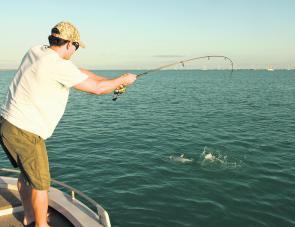In the last couple of issues, we’ve looked at hooking and playing that trophy fish – now it’s time to think about actually landing the catch!
Many good fish that escape capture and add to the growing list of ‘one that got away’ stories are lost in either the first or last few seconds of the encounter. Of the two, the riskiest moment is when that lovely big fish finally swims into view after a drawn out battle. At this point, it’s perfectly natural to feel a powerful surge of excitement, accompanied by an overwhelming desire to haul that prized catch to safety as quickly as possible. However, this desire can be disastrous!
It’s best to take a deep breath at this point and calmly assess your options, although that’s often easier said than done after a white-knuckled and dramatic fight with what might potentially be the fish of a lifetime.
How you actually land your prize catch depends on many factors, including where you’re fishing, the gear you’re using and the size of the fish itself. However, regardless of all these variables, having a solid game plan in mind about how you’re going to achieve that desired end result before you even cast your line means the battle is half won. Making plans on the run and under pressure is never a great idea.
The following four approaches are the most common methods used to land fish:
Smaller fish can often be swung from the water by using the rod rather like a crane, or by grasping the line or leader and lifting the fish. The risks are that hooks can pull free and that even relatively small fish can snap finer lines, or even break rod tips, especially if they kick powerfully at the wrong moment.
When fishing from a beach, river bank or sloping, rocky shoreline, dragging the fish towards you along the ground rather than lifting or swinging it up through the air is generally a safer approach. Whenever possible, you can also use an incoming wave or surge of water to help bring in the fish, especially when surf or rock fishing. With practice, it’s possible to land quite large fish this way.
In many cases, you or an assistant may be able to physically pick the fish up from the water, grasping it by the wrist of the tail, its jaws or the gills, or by simply placing one or both hands underneath the fish and lifting or scooping it up.
However, you really shouldn’t attempt to pick up any fish, even with gloves, unless you’re absolutely sure of the species you’ve hooked and know all about the fish’s physiology. A number of species have venomous spines, sharp gill covers, spiky scales, sharp teeth or some combination of these features that can inflict nasty injuries on the unwary.
Fish are also slippery and prone to kicking at the wrong moment, meaning that many attempts at a grab and lift end in disaster!
With unknown or unfamiliar species, larger catches or when fishing from a boat, jetty, pier or higher rock ledge, by far the safest method of bringing in any reasonable fish is to use a landing net or gaff. Nets are far more popular than gaffs (and nets are really the only choice if catch-and-release is to be an option), but gaffs are particularly useful on very large, active fish that are going to be kept.
Over the next couple of issues, we’ll look in detail at the where, when, how and why of successful net and gaff use.
Reads: 1457
This is when so many fish are lost! A lovely tuna circles at short range after a torrid fight on light tackle.

So close! And now the over-riding urge is to heave the fish into the boat…but how? Should you tail it, net it or gaff the tuna?

Some fish, like barramundi, can be effectively jaw gripped – careful of the hooks, though!

Smaller fish hooked on heavier gear can be lifted or ‘swung’ up from the water.




